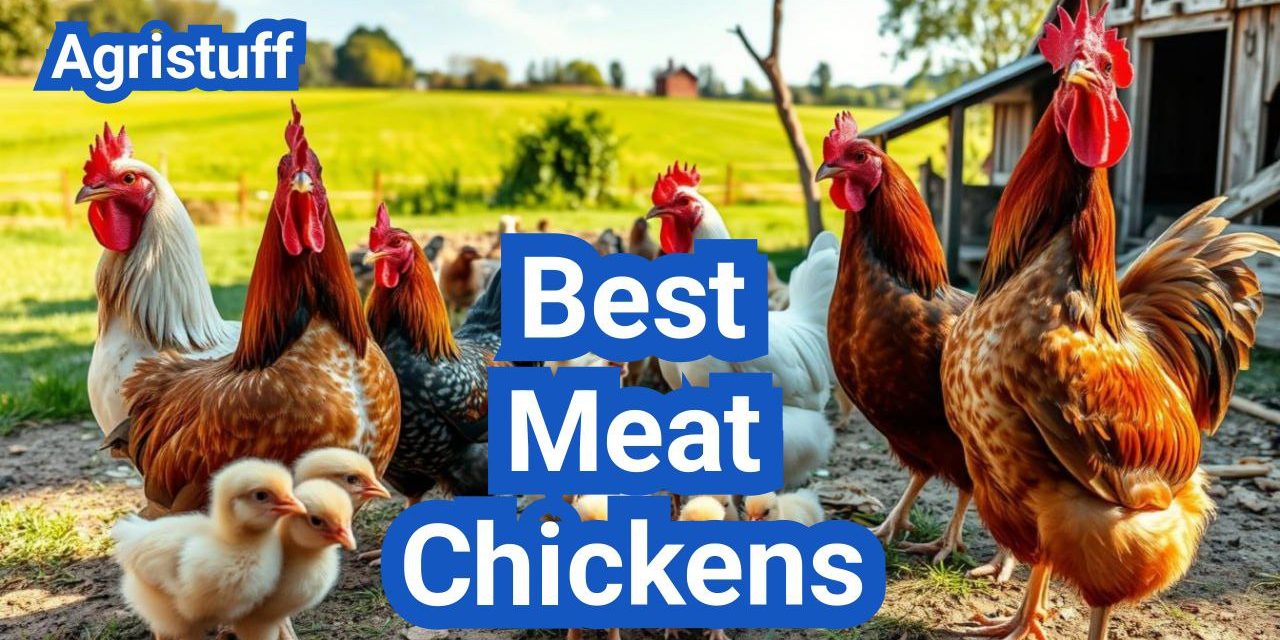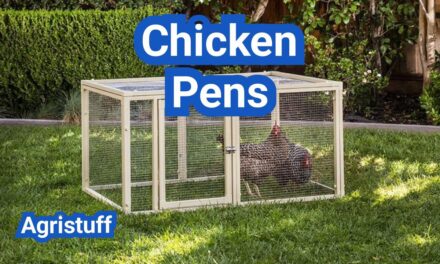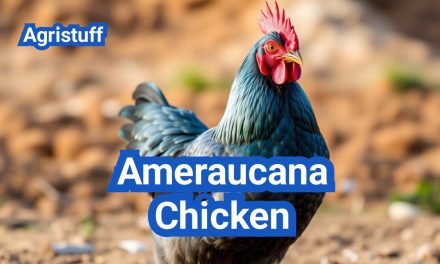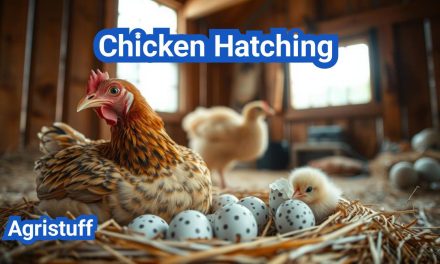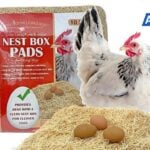Raising best meat chickens can be a rewarding experience, especially when you choose the right breed for quality poultry meat. With numerous breeds available, selecting the best one can be daunting. The key is to identify breeds that offer a balance between growth rate, meat quality, and ease of care.
When it comes to raising meat chickens, factors such as climate, available space, and desired meat characteristics play a crucial role in breed selection. Some breeds are better suited for small backyard farms, while others are ideal for larger commercial operations.
Key Takeaways
- Choosing the right breed is crucial for quality poultry meat.
- Consider factors like climate, space, and meat characteristics.
- Top breeds offer a balance between growth rate and ease of care.
- Some breeds are ideal for small backyard farms.
- Others are better suited for larger commercial operations.
Understanding Meat Chickens and Their Importance
Understanding the importance of best meat chickens is crucial for anyone looking to start or improve their poultry farming. Meat chickens, also known as broilers, are bred specifically for their meat production. Raising meat birds can be a cost-effective and rewarding experience, offering numerous benefits for backyard farmers and commercial producers alike.
What Makes a Good Meat Chicken
A good meat chicken breed is characterized by its growth rate, feed conversion ratio, and meat quality. Breeds like the Cornish Cross are popular for their fast growth rate and efficient feed conversion, making them ideal for commercial production. “The choice of breed depends on the farmer’s goals, whether it’s for small-scale backyard production or large-scale commercial operations,” says poultry expert John Smith.
When selecting a breed, factors such as climate hardiness, disease resistance, and market demand should be considered. For instance, breeds like the Red Ranger are known for their robust health and suitability for free-range systems.
Economic Benefits of Raising Your Own Meat Birds
Raising your own best meat chickens can be economically beneficial, as it allows you to control the production costs and quality of the final product. By choosing the right breed and managing the flock effectively, farmers can achieve significant savings compared to purchasing meat from external sources.
- Reduced reliance on external meat suppliers
- Potential for selling surplus birds to other farmers or at local markets
- Lower long-term costs through sustainable practices
Health and Quality Advantages of Home-Raised Poultry
Home-raised poultry offers several health and quality advantages over commercially sourced meat. By controlling the diet and living conditions of the chickens, farmers can ensure that the meat is free from antibiotics and other chemicals commonly used in industrial farming.
“Home-raised poultry is not just about the meat; it’s about the experience and the quality of life for both the chickens and the farmers,” notes Jane Doe, a sustainable farming advocate.
The result is higher quality meat that is richer in nutrients and has better flavor. This aspect is particularly appealing to consumers who are willing to pay a premium for sustainably produced meat.
Hybrid vs. Heritage Breeds: Key Differences

Understanding the differences between hybrid and heritage chicken breeds is essential for optimal meat production. The choice between these two types of breeds significantly impacts the quality, sustainability, and profitability of your poultry operation.
Growth Rate and Feed Conversion Comparisons
Hybrid broilers, such as the Cornish Cross, are renowned for their fast growth rate, reaching market weight in as little as 6 weeks. In contrast, heritage breeds take longer to mature, often requiring 12-16 weeks to reach a similar weight. This difference is largely due to selective breeding for rapid growth in hybrid birds.
Feed conversion ratio (FCR) is another critical factor. Hybrid breeds generally have a lower FCR, meaning they convert feed into body weight more efficiently. For instance, a study comparing hybrid and heritage breeds found that hybrids had an FCR of 1.8, while heritage breeds had an FCR of 2.5.
| Breed Type | Growth Rate (weeks) | Feed Conversion Ratio |
|---|---|---|
| Hybrid Broilers | 6-7 | 1.8 |
| Heritage Breeds | 12-16 | 2.5 |
Flavor and Meat Quality Considerations
While hybrid breeds excel in growth rate and feed efficiency, heritage breeds are often praised for their superior flavor and meat quality. The slower growth rate of heritage breeds allows for more marbling, which can enhance the tenderness and taste of the meat.
Consumers seeking premium, pasture-raised poultry often prefer heritage breeds for their rich flavor profile. In contrast, hybrid breeds are commonly used in commercial production due to their efficiency and consistency.
Sustainability and Long-Term Breeding Potential
Heritage breeds offer significant advantages in terms of sustainability and long-term breeding potential. They are generally hardier and more adaptable to various environments, making them suitable for small-scale, pasture-based systems.
Sustainability is enhanced with heritage breeds as they can be bred on-farm, reducing reliance on external suppliers. Additionally, heritage breeds contribute to genetic diversity, preserving traits that could be valuable in the face of future challenges.
In conclusion, the choice between hybrid and heritage breeds depends on your production goals, market demands, and farming practices. By understanding the key differences, you can make informed decisions that optimize your poultry operation’s efficiency, quality, and sustainability.
Best Meat Chickens for Commercial Production
Commercial poultry production relies heavily on breeds that offer fast growth rates and high-quality meat. The right breed can significantly impact the efficiency and profitability of a commercial operation.
Cornish Cross: The Industry Standard
The Cornish Cross is widely regarded as the industry standard for commercial broiler production. Its fast growth rate and efficient feed conversion make it an ideal choice for large-scale operations.
Key characteristics of Cornish Cross:
- Fast growth rate, reaching market weight in 5-6 weeks
- Efficient feed conversion ratio
- High yield of breast meat
Sasso Broilers: The European Alternative
Sasso Broilers offer a slower growth rate compared to Cornish Cross but are known for their superior meat quality and flavor. They are a popular choice in European markets where consumers are willing to pay a premium for higher-quality poultry.
Advantages of Sasso Broilers:
- Improved meat quality and flavor
- Robust health and hardiness
- Suitable for free-range and organic production systems
Jumbo Cornish Cross Variations
Jumbo Cornish Cross variations are bred to achieve even larger sizes than the standard Cornish Cross. These birds are ideal for markets that demand larger chickens.
Features of Jumbo Cornish Cross:
- Larger market weight
- Maintains the fast growth rate and efficient feed conversion of the standard Cornish Cross
- Suitable for niche markets demanding larger birds
When choosing a breed for commercial production, it’s essential to consider factors such as growth rate, feed conversion, and market demand. The following table compares the key characteristics of Cornish Cross, Sasso Broilers, and Jumbo Cornish Cross:
| Breed | Growth Rate | Feed Conversion | Market Weight |
|---|---|---|---|
| Cornish Cross | Fast (5-6 weeks) | Efficient | 4-5 lbs |
| Sasso Broilers | Slower (8-12 weeks) | Less efficient | 3-4 lbs |
| Jumbo Cornish Cross | Fast (6-7 weeks) | Efficient | 6-8 lbs |
By understanding the strengths and weaknesses of each breed, commercial producers can make informed decisions that align with their production goals and market demands.
Top Meat Chickens for Homesteaders

When it comes to choosing the best meat chickens for homesteading, factors such as growth rate, meat quality, and foraging ability are crucial. Homesteaders need breeds that can thrive in their specific environments while providing high-quality meat.
Red Rangers: The Pastured Poultry Champion
Red Rangers are a popular choice among homesteaders due to their excellent foraging abilities and flavorful meat. They are well-suited for pastured poultry systems, offering a more natural and sustainable approach to raising meat chickens.
- Robust Foraging Ability: Red Rangers are known for their active foraging behavior, which contributes to their rich flavor profile.
- Slow Growth Rate: Compared to commercial broilers, Red Rangers have a slower growth rate, which allows for more developed muscle and better meat quality.
- Hardiness: They are generally hardy and adaptable to various environments, making them suitable for different homesteading setups.
Freedom Rangers and Kosher King Varieties
Freedom Rangers and Kosher King are other notable breeds for homesteaders. They offer a balance between growth rate and meat quality, making them suitable for small-scale production.
Freedom Rangers are known for their:
- Excellent Growth Rate: They grow relatively fast, reaching market weight in a reasonable timeframe.
- Meat Quality: The meat is of high quality, with good texture and flavor.
Kosher King birds are recognized for their:
- Fast Growth: Kosher Kings are bred for their rapid growth rate, making them efficient for meat production.
- Meat Yield: They provide a good meat yield, suitable for homesteaders looking to produce meat for their families or small-scale sales.
Color Yield Broilers for Small-Scale Production
Color Yield Broilers are another excellent option for homesteaders engaged in small-scale production. They are known for their colorful plumage and robust health.
- Diverse Genetics: Their diverse genetic background contributes to their hardiness and adaptability.
- Meat Production: They offer a good balance between growth rate and meat quality, making them suitable for homesteaders seeking to raise chickens for meat.
In conclusion, breeds like Red Rangers, Freedom Rangers, Kosher King, and Color Yield Broilers are top choices for homesteaders due to their unique characteristics and suitability for small-scale, pastured poultry production.
Heritage Meat Chicken Breeds Worth Raising
Raising heritage best meat chickens can be a rewarding experience, providing both quality meat and a connection to traditional farming practices. These breeds are known for their unique characteristics and flavors, making them a great choice for those looking to diversify their poultry production.
Jersey Giants: The American Heavyweight
Jersey Giants are a popular heritage breed known for their large size and gentle nature. They are one of the heaviest chicken breeds, with roosters weighing up to 13 pounds. This breed is prized for its meat production and is considered a great choice for small farms.
Key Characteristics of Jersey Giants:
- Large size, with roosters weighing up to 13 pounds
- Gentle disposition, making them easy to handle
- Good foragers, suitable for free-range systems
- Rich, flavorful meat
White Chantecler: The Canadian Cold-Weather Breed
The White Chantecler is a heritage breed developed in Canada for its cold hardiness and egg-laying abilities. While it is a dual-purpose breed, it is also raised for its meat, which is known for being tender and flavorful.
“The Chantecler chicken is a proud and ancient breed, known for its cold hardiness and rich flavor.” – Poultry expert
| Breed | Weight | Cold Hardiness | Meat Quality |
|---|---|---|---|
| White Chantecler | 6-8 pounds | High | Rich, tender |
| Jersey Giants | 10-13 pounds | Medium | Flavorful, meaty |
| Bresse | 5-7 pounds | Low | Gourmet, fine texture |
Bresse: The French Gourmet Option
Bresse is a renowned heritage breed from France, celebrated for its exquisite meat. It is considered a gourmet option due to its fine texture and rich flavor. Bresse chickens are raised under strict conditions to maintain their quality and authenticity.
Bresse chickens are a testament to the rich culinary tradition of France, offering a dining experience like no other.
Best Dual-Purpose Chicken Breeds

If you’re seeking a chicken breed that can provide both a steady supply of eggs and a source of meat, consider dual-purpose breeds. These versatile chickens are ideal for homesteaders and backyard enthusiasts looking to maximize their poultry production.
Barred Plymouth Rocks: The Classic Choice | Best Meat Chickens
Barred Plymouth Rocks are a popular dual-purpose breed known for their friendly disposition and high productivity. They lay around 280 brown eggs per year and have a substantial body size, making them suitable for meat production. Their hardiness and adaptability to various climates add to their appeal.
Key benefits: Friendly, prolific egg layers, suitable for meat production, hardy.
Orpingtons: Cold-Hardy Meat Producers | Best Meat Chickens
Orpingtons are another excellent choice for those looking for a dual-purpose breed. They are known for their cold hardiness and can thrive in cooler climates. Orpingtons lay around 180-200 brown eggs annually and have a meaty body, making them a great option for both eggs and meat.
Cold hardiness is a significant advantage of Orpingtons, allowing them to maintain productivity even in harsh winter conditions.
New Hampshire Reds: Reliable Meat and Egg Birds
New Hampshire Reds are a robust breed that excels in both egg and meat production. They are known for their fast growth rate and lay around 200 brown eggs per year. Their friendly nature and relatively low maintenance make them a favorite among backyard chicken keepers.
- Fast growth rate
- Prolific egg layers
- Friendly disposition
By choosing dual-purpose breeds like Barred Plymouth Rocks, Orpingtons, and New Hampshire Reds, backyard chicken enthusiasts can enjoy a steady supply of both eggs and meat, making their poultry-keeping endeavors more rewarding and productive.
Best Meat Chickens for Beginners

New to raising meat chickens? The key to a thriving flock lies in selecting easy-to-raise breeds. For beginners, it’s essential to choose breeds that are not only hardy but also easy to manage.
Easy-to-Raise Breeds for First-Time Chicken Keepers | Best Meat Chickens
When it comes to easy-to-raise breeds, several options stand out for their robustness and simplicity in care. Some of the top breeds include:
- Cornish Cross: Known for their fast growth rate and large size.
- Red Rangers: Prized for their foraging ability and lean meat.
- Freedom Rangers: A popular choice for their hardiness and flavor.
These breeds are ideal for novice farmers because they are relatively low maintenance and can thrive in various conditions.
Management Considerations for Novice Farmers | Best Meat Chickens
Management considerations are crucial for the success of any poultry operation. Novice farmers should focus on providing adequate housing, nutrition, and health care. Here are some key factors to consider:
| Factor | Description | Importance Level |
|---|---|---|
| Nutrition | Providing the right feed for optimal growth. | High |
| Housing | Ensuring safe and healthy living conditions. | High |
| Health Care | Regular monitoring and preventative care. | High |
Common Mistakes to Avoid When Starting Out | Best Meat Chickens
Avoiding common mistakes is vital for beginners. Some of the most frequent errors include underestimating the space and resources needed, not planning for health issues, and failing to research local regulations. By being aware of these potential pitfalls, novice farmers can better prepare themselves for the challenges of raising meat chickens.
By focusing on easy-to-raise breeds and being mindful of management considerations, beginners can set themselves up for success in the world of poultry farming.
Raising Meat Chickens on Pasture

Pastured poultry systems offer a sustainable alternative to traditional confinement methods for raising meat chickens. This approach to poultry farming not only enhances the welfare of the animals but also produces meat that is often considered more flavorful and nutritious.
Benefits of Pastured Poultry Systems | Best Meat Chickens
Raising meat chickens on pasture provides several benefits, including improved animal welfare, better meat quality, and potential environmental advantages. Pastured poultry systems allow chickens to engage in natural behaviors such as foraging, which can lead to more complex and satisfying flavor profiles in the meat.
The welfare of the chickens is improved through access to fresh air, sunlight, and space to move, reducing the risk of health issues associated with confinement. Additionally, pastured systems can contribute to soil health through the chickens’ foraging activities, which can help to distribute nutrients and aerate the soil.
Suitable Breeds for Free-Range Environments | Best Meat Chickens
Not all chicken breeds are equally suited to free-range or pastured environments. Breeds that are known for their hardiness and foraging ability tend to perform well in these systems. Red Rangers and Freedom Rangers are examples of breeds that are often used in pastured poultry production due to their growth rates and ability to thrive on pasture.
When selecting breeds for pastured systems, it’s essential to consider factors such as growth rate, foraging ability, and resistance to predators. Some heritage breeds also excel in free-range environments, offering the added benefit of unique flavor profiles.
Rotational Grazing and Mobile Coop Designs | Best Meat Chickens
Rotational grazing is a critical component of successful pastured poultry systems. By regularly moving the chickens to fresh areas of pasture, farmers can prevent overgrazing, reduce parasite loads, and maintain soil health. This practice requires careful planning and often involves the use of mobile coop designs that can be easily moved to new locations.
Mobile coop designs vary, but they typically include features such as protection from predators, adequate ventilation, and easy access for feeding and watering. Some systems also incorporate automated or mechanized elements to simplify the process of moving the coops.
Breeding Your Own Meat Chickens

Breeding your own meat chickens can be a rewarding experience, offering a sustainable source of high-quality poultry meat. This approach allows you to control the genetics, health, and quality of your flock, ensuring a consistent supply of fresh meat.
Self-Sustaining Flocks: Breeds That Reproduce Well | Best Meat Chickens
To establish a self-sustaining flock, it’s crucial to select breeds known for their reproductive capabilities. Heritage breeds are often preferred for their ability to reproduce naturally and thrive in various environments. Breeds like the Jersey Giant and White Chantecler are known for their strong maternal instincts and robust health.
When choosing breeds for a self-sustaining flock, consider factors such as fertility, growth rate, and overall hardiness. This ensures that your flock remains healthy and productive over generations.
Selective Breeding for Improved Meat Production | Best Meat Chickens
Selective breeding is a powerful tool for enhancing meat production in your flock. By choosing birds with desirable traits such as faster growth rates, better feed conversion, and improved meat quality, you can significantly enhance your poultry production. It’s essential to maintain detailed records of your breeding program to track progress and make informed decisions.
Key traits to focus on include growth rate, meat yield, and disease resistance. By selectively breeding for these characteristics, you can develop a flock that is not only more productive but also more resilient to diseases.
Maintaining Genetic Diversity in Your Flock | Best Meat Chickens
Maintaining genetic diversity is critical for the long-term health and sustainability of your flock. A diverse gene pool helps protect against disease outbreaks and ensures that your flock can adapt to changing environmental conditions. To achieve this, it’s advisable to introduce new genetics periodically and avoid inbreeding.
Practices such as rotating breeding stock and using a diverse range of breeds can help maintain genetic diversity. This approach not only enhances the health of your flock but also improves its overall productivity and resilience.
Nutrition Requirements for Quality Meat Production

Understanding the nutritional needs of meat chickens is essential for successful poultry production. Nutrition plays a critical role in determining the quality of the final product, influencing factors such as growth rate, meat texture, and flavor.
Feed Conversion Ratios Explained | Best Meat Chickens
Feed conversion ratio (FCR) is a crucial metric in poultry production, measuring the efficiency with which chickens convert feed into body weight. A lower FCR indicates better feed efficiency, which is desirable for reducing production costs and environmental impact.
The FCR varies among breeds and is influenced by factors such as genetics, nutrition, and management practices. For instance, fast-growing broiler breeds like the Cornish Cross typically have a lower FCR compared to slower-growing heritage breeds.
| Breed | Average FCR | Growth Rate |
|---|---|---|
| Cornish Cross | 1.7-1.9 | Fast |
| Red Ranger | 2.5-2.7 | Medium |
| Jersey Giant | 3.0-3.2 | Slow |
Best Commercial and Organic Feed Options | Best Meat Chickens
Choosing the right feed is vital for optimal meat chicken production. Commercial feeds are formulated to meet the nutritional needs of chickens at different stages of growth. Organic feed options are available for producers interested in organic or pasture-raised systems.
Some popular commercial feed brands include Purina and Kalmbach, which offer a range of products tailored to different poultry production systems. For organic production, feeds certified by organizations such as the USDA Organic program are preferred.
Supplemental Feeding Strategies for Optimal Growth
Supplemental feeding can enhance the nutritional profile of meat chickens, promoting optimal growth and health. Strategies include providing additional grains, insects, or other nutrient-rich supplements.
For example, adding mealworms to the diet can increase protein intake, while offering oats or barley can provide fiber. It’s essential to balance supplemental feeding with the primary feed to avoid nutritional imbalances.
Housing and Care Requirements
To ensure the well-being of meat chickens, it’s vital to provide appropriate housing and care. Proper housing and care are essential for maintaining the health and productivity of your flock.
Space Requirements for Healthy Meat Birds
Providing adequate space is crucial for the health and welfare of meat chickens. Overcrowding can lead to stress, disease, and reduced growth rates. The recommended space per bird varies depending on the breed and growth rate.
For fast-growing breeds like Cornish Cross, it’s recommended to provide at least 2-3 square feet per bird inside the coop. For slower-growing breeds, you can start with about 1-2 square feet per bird.
| Breed | Recommended Space per Bird (sq ft) | Growth Rate |
|---|---|---|
| Cornish Cross | 2-3 | Fast |
| Red Rangers | 1-2 | Medium |
| Heritage Breeds | 1-2 | Slow |
Temperature and Ventilation Considerations | Best Meat Chickens
Maintaining the right temperature and ensuring proper ventilation are critical for the health of meat chickens. Temperature control helps in preventing heat stress and maintaining optimal growth conditions.
For young chicks, the temperature should be around 90-95°F during the first week, gradually decreasing as they grow. Ventilation is equally important to remove moisture and ammonia from the coop.
Bedding and Sanitation Best Practices | Best Meat Chickens
Choosing the right bedding material and maintaining cleanliness are vital for the health of your meat chickens. Common bedding materials include straw, pine shavings, and sand.
- Regularly clean and replace bedding to prevent ammonia buildup.
- Ensure the coop is dry to prevent disease.
- Monitor for pests and maintain a clean environment.
By following these guidelines for housing and care, you can significantly improve the health and productivity of your meat chickens.
Health Management for Meat Chickens
Meat chicken health management involves a comprehensive approach to prevent disease and ensure the well-being of the flock. Effective health management is critical for raising healthy meat chickens, particularly fast-growing breeds that are prone to specific health issues.
Common Health Issues in Fast-Growing Breeds | Best Meat Chickens
Fast-growing meat chicken breeds are susceptible to various health issues due to their rapid growth rate. Some of the most common health problems include:
- Leg issues due to excessive weight gain
- Heart problems resulting from rapid growth
- Susceptibility to diseases due to compromised immune systems
According to a study published in the Journal of Applied Poultry Research, “The incidence of leg disorders in broilers is a major welfare concern and can have significant economic implications for producers” (
). Monitoring the health of these birds closely is essential to mitigate these risks.
Preventative Care and Monitoring | Best Meat Chickens
Preventative care is a crucial aspect of health management for meat chickens. This includes:
| Preventative Measure | Description | Benefits |
|---|---|---|
| Vaccination | Administering vaccines to protect against diseases | Reduces disease incidence, improves flock health |
| Proper Nutrition | Providing balanced feed that meets nutritional needs | Supports healthy growth, strengthens immune system |
| Sanitation and Hygiene | Maintaining clean living conditions | Reduces risk of disease, improves overall health |
Regular monitoring of the flock’s health is vital. Farmers should be vigilant for signs of illness or stress, such as changes in behavior, appetite, or physical condition.
Natural and Medicinal Treatment Options | Best Meat Chickens
When health issues arise, farmers have various treatment options to consider. Natural treatments, such as herbal remedies and probiotics, can be effective for certain conditions. Medicinal treatments, including antibiotics, may be necessary for bacterial infections.
It’s crucial to consult with a veterinarian to determine the best course of treatment for specific health issues. As emphasized by poultry health experts, “A comprehensive health management plan should include both preventative measures and effective treatment strategies” (emphasizing the importance of a multi-faceted approach).
By adopting a proactive and comprehensive health management strategy, farmers can significantly improve the health and well-being of their meat chickens, leading to a more sustainable and productive farming operation.
Determining Optimal Butchering Age and Weight

Butchering age and weight are critical factors in meat chicken production, influencing both the flavor and the yield of the final product. Understanding these factors is essential for producers aiming to optimize their operations for quality and efficiency.
Growth Timelines for Different Breeds | Best Meat Chickens
Different breeds of meat chickens have unique growth timelines that significantly impact the optimal butchering age. For instance, fast-growing breeds like the Cornish Cross reach market weight in as little as 6-7 weeks, while slower-growing heritage breeds may take 12-16 weeks or more.
Fast-growing breeds are often used in commercial production due to their efficient feed conversion and rapid growth rate. In contrast, heritage breeds are prized for their flavor and are typically raised on pasture or in free-range systems.
Quality vs. Quantity Considerations | Best Meat Chickens
Producers must balance the desire for quantity (yield) with the need for quality (flavor, texture, and appearance). While faster-growing birds may offer higher yields, they can sometimes lack the flavor and texture of slower-growing birds.
- Quantity-focused production often prioritizes fast growth rates and high yield.
- Quality-focused production may opt for slower-growing breeds and more extensive rearing systems.
Seasonal Factors Affecting Processing Decisions | Best Meat Chickens
Seasonal demand and environmental conditions can also influence the optimal butchering age and weight. For example, in regions with harsh winters, it may be more challenging to raise birds to maturity, potentially shifting the optimal butchering age.
Understanding these seasonal factors can help producers plan their operations more effectively, ensuring they meet market demand while maintaining the quality of their product.
Processing Techniques for High-Quality Meat
To achieve the best flavor and texture, it’s essential to understand the processing techniques for meat chickens. The processing stage is critical as it directly impacts the final product’s quality, safety, and flavor.
Humane Slaughter Methods | Best Meat Chickens
Humane slaughter methods are crucial for minimizing stress and ensuring the welfare of the animals. Techniques such as captive bolt stunning or electrical stunning are commonly used to render the birds unconscious before slaughter. These methods not only improve animal welfare but also contribute to better meat quality by reducing the risk of injury and stress.
Proper Cleaning and Preparation Procedures | Best Meat Chickens
After slaughter, proper cleaning and preparation procedures are vital for maintaining meat quality. This includes evisceration, washing, and chilling the carcasses to prevent contamination and spoilage. It’s also important to follow food safety guidelines to ensure the meat is safe for consumption.
| Procedure | Purpose | Best Practice |
|---|---|---|
| Evisceration | Removal of internal organs | Perform carefully to avoid contamination |
| Washing | Cleaning the carcass | Use cold water to reduce bacterial growth |
| Chilling | Reducing bacterial growth | Chill to below 4°C within 2 hours |
Aging and Storage for Improved Flavor | Best Meat Chickens
Aging and proper storage are key factors in enhancing the flavor and tenderness of the meat. Aging allows the natural enzymes in the meat to break down the proteins and fats, resulting in more tender and flavorful meat. Storage conditions, such as maintaining a consistent refrigerator temperature below 4°C, are crucial for slowing down bacterial growth and preserving meat quality.
By implementing these processing techniques, producers can significantly improve the quality of their meat chickens, ensuring a better product for consumers.
Choosing the Right Meat Chickens for Your Needs
Choosing the right breed of meat chicken is crucial for achieving your desired outcomes, whether you’re raising birds for commercial production, homesteading, or personal consumption. Factors such as purpose, climate, and available resources play a significant role in determining the best breed for your needs.
By understanding the characteristics of different breeds, you can make an informed decision that suits your specific requirements. For instance, breeds like Cornish Cross are ideal for commercial production due to their fast growth rate, while heritage breeds like Jersey Giants offer superior flavor and are well-suited for small-scale farming.
Ultimately, selecting the right meat chickens involves considering your goals, resources, and the needs of your operation. By doing so, you can ensure a successful and sustainable poultry-raising experience that meets your needs and provides high-quality meat.
FAQ
Can any chicken be a meat chicken?
While any chicken can be raised for meat, certain breeds are more suitable due to their growth rate, feed conversion, and meat quality.
Is it worth raising chickens for meat?
Raising chickens for meat can be cost-effective and result in higher quality meat compared to store-bought options, making it a worthwhile endeavor for many.
What is the fastest-growing meat chicken?
Breeds like Cornish Cross and Jumbo Cornish Cross are known for their fast growth rates, making them popular choices for commercial meat production.
What are the best meat chickens for beginners?
Easy-to-raise breeds such as Red Rangers and Freedom Rangers are great for beginners due to their hardiness and ease of management.
What are the benefits of raising meat chickens on pasture?
Pastured poultry systems offer numerous benefits, including improved meat quality, animal welfare, and environmental sustainability.
How do I determine the optimal butchering age and weight for my meat chickens?
The optimal butchering age and weight depend on factors such as breed, growth rate, and desired meat quality, requiring careful consideration of these factors.
What are the key nutrition requirements for quality meat production?
Providing the right balance of nutrients through commercial or organic feed options, along with supplemental feeding strategies, is crucial for optimal growth and meat quality.
How can I maintain the health of my meat chickens?
Implementing preventative care measures, monitoring health closely, and using natural or medicinal treatments when necessary are essential for maintaining the health of your flock.
What are the best practices for processing meat chickens?
Ensuring humane slaughter, proper cleaning and preparation, and appropriate aging and storage techniques are vital for producing high-quality meat.
Can I breed my own meat chickens?
Yes, breeding your own meat chickens requires selecting self-sustaining breeds, practicing selective breeding, and maintaining genetic diversity within your flock.
Conclusion of: Best Meat Chickens
When you search Best Meat Chickens, you’re looking for breeds that deliver excellent meat quality, efficient feed conversion, ease of raising, and reliable availability—especially in the USA. This article explores how to choose Best Meat Chickens, reviews six top-performing breeds, compares their growth and processing metrics, and shares practical tips for raising healthier, tastier birds.
🔗 For more on poultry breed selection, see the USDA’s guidelines: USDA Poultry Production
Criteria for Choosing Best Meat Chickens
Every backyard flock or small-scale commercial operation aiming to raise Best Meat Chickens should evaluate four key criteria:
- Growth rate and feed conversion – Lower feed-to-weight ratio (like 2 lb feed per 1 lb live weight) equals more economical meat.
🔗 Learn about feed efficiency from the University of Georgia Extension: Poultry Feed Management - Yield and dressing percentage – Dressed weight ideally 65–75% of live weight after feathers and giblets are removed.
🔗 Meat yield research from Penn State Extension: Poultry Processing Basics - Health and robustness – Fewer genetic leg or heart issues, better cold or heat tolerance.
🔗 Poultry health insights from the CDC: CDC Poultry Farming Safety - Flavor, texture, and market appeal – Especially critical for niche markets and pasture-raised birds.
🔗 Consumer preferences study by Purdue University: Meat Quality Research
These criteria define the reputation of Best Meat Chickens and guide informed decisions from chick order through harvest.
Cornish Cross: America’s Standard Best Meat Chickens
When naming Best Meat Chickens, the Cornish Cross hybrid rises to the top thanks to its rapid growth—often reaching 5–6 lb dressed weight in just 6–9 weeks—with feed conversion as efficient as 1.8–2 lb feed per 1 lb live body weight.
These chickens are bred expressly for meat: broad breast, tender white meat, minimal feathers (“hairless”), and a consistent, uniform carcass. Typical small producers process them at around 8 weeks for peak yield and welfare balance.
🔗 Animal welfare insights from the Livestock Conservancy: Heritage vs. Hybrid Chickens
In many homestead or small-farm setups, the Cornish Cross is considered a go-to if efficiency, volume, and predictability are your primary concerns in choosing Best Meat Chickens.
Freedom Ranger & Red Ranger: Pasture‑Friendly Best Meat Chickens
As consumer demand rises for humanely raised and pasture‑raised poultry, Freedom Rangers and Red Rangers have emerged as favored Best Meat Chickens for their robust legs, sensible growth, and richer taste. These four‑way hybrid strains reach 5–6 lb live weight in 9–13 weeks, typically requiring 2.4–2.7 lb of feed per pound of live weight.
🔗 Pastured poultry guide from ATTRA (National Sustainable Agriculture Center): Raising Meat Chickens on Pasture
These less extreme growers avoid the leg and heart problems that can beset Cornish Cross birds if over‑fed, making them hardier on pasture or in mobile tractors. Tasters often describe the dark meat as more “juicy” and “flavorful” compared to Cornish Cross.
🔗 Meat quality comparison from the University of Kentucky: Pastured Poultry Meat Quality
Rangers also tend to forage better, promoting better health and meat quality—key traits making them among the Best Meat Chickens for ethical and small‑scale producers.
Plymouth Rock (Barred Rock): Dual‑Purpose Best Meat Chickens
Barred Plymouth Rock, a classic American dual-purpose breed, ranks among Best Meat Chickens for homesteads that want eggs and meat from the same flock. Hens weigh 7–8 lb and roosters around 9–10 lb, delivering a respectable 4–5 lb of dressed meat with slower development and hardy efficiency.
🔗 Breed profile from the American Poultry Association: Plymouth Rock Standard
Known for their sweet, docile temperament and cold tolerance, Barred Rocks also lay approximately 200 large brown eggs per year. While they don’t grow as fast as Cornish Cross or Rangers, they offer versatility and reduced startup costs—an excellent pick for those seeking Best Meat Chickens that provide both protein and eggs year-round.
🔗 Dual-purpose breed guide from Oregon State Extension: Backyard Chicken Breeds
Jersey Giant: Heritage‑Heavy Best Meat Chickens for Volume
Jersey Giants are among the largest chicken breeds developed in New Jersey around the 1890s, bred to rival small turkeys for meat production. With cocks reaching up to 13 lb live weight, they yield substantial portions—but take 14–18 months to mature.
🔗 Heritage breed preservation from The Livestock Conservancy: Jersey Giant Profile
Though not efficient compared to industrial broilers, their mild flavor, large cuts, and calm nature make them stand out to producers prioritizing quality and size. They are cold-hardy but heat-sensitive and suited to extensive grazing systems. Their unique stature and meat yield qualify them as niche selections within Best Meat Chickens for patience-driven, heritage farm operations.
Sasso (Indian Game Hybrid): European‑Style Best Meat Chickens
Sasso broilers and descendants like Indian Game crosses bring European slow-growth standards to those seeking flavorful, free-range Best Meat Chickens. These birds typically reach 7–8 lb live weight at 10–12 weeks, with a mild feed conversion around 2.4–2.7 lb feed per live weight.
🔗 Slow-growth poultry research from Clemson University: Alternative Meat Chicken Breeds
Their deep-bodied frame, firm thighs, and game-style texture set them apart from American hybrids. They are more active, forage vigorously, and their aesthetically appealing feathering can support premium market pricing. For farms seeking grass-fed or free-range labels, Sasso-type birds rank high among Best Meat Chickens for taste, appearance, and ethical value.
Comparing Growth, Feed Conversion & Meat Yield of Best Meat Chickens
| Breed / Strain | Processing Age | Live Weight at Processing | Typical Feed Conversion (FCR) | Dressed Yield % | Meat Texture / Flavor |
|---|---|---|---|---|---|
| Cornish Cross | 6‑9 weeks | ~5–6 lb live / ~3.5–4 lb dressed | ~1.8–2 (live weight) → ~2.2 for dress | 65–70% | Very tender; mild white meat |
| Freedom / Red Rangers | 9‑13 weeks | 5–6 lb live / ~3–4 lb dressed | ~2.4–2.7 | 60–65% | Juicier, richer dark meat; firm breasts |
| Plymouth Rock (heritage) | 16‑20 weeks | ~9 lb live / ~5–6 lb dressed | ~3.0–3.5 | 55–60% | Balanced white/dark meat; good flavor |
| Sasso / Indian Game hybrid | 10‑12 weeks | 7–8 lb live / ~4.5–5.5 lb dressed | ~2.4–2.7 | 63–65% | Game-style texture; firm and richly colored |
| Jersey Giant (heritage) | 40–60+ weeks | 13 lb+ live / ~8–9 lb dressed | ~4.0+ | ~60% | Loose texture; large cuts, subtle flavor |
These metrics highlight how Best Meat Chickens vary by priorities—quick yield vs flavor, efficiency vs size vs heritage authenticity, and breed‑specific market positioning.
Raising Best Meat Chickens: Practical Tips for Healthy Flocks
Successfully raising Best Meat Chickens involves more than picking the right breed—it requires careful management:
- Start with SPF (Specific‑Pathogen‑Free) chicks to minimize early disease risk, especially for Cornish Cross at high‑density systems.
- Transition onto pasture early (after ~10–14 days with coop heat), especially for Rangers and Sasso, to develop forage behaviors and muscle structure.
- Use a clean, well‑managed chicken tractor or mobile pen—rotate daily or twice daily to prevent soil exhaustion and parasite buildup.
- Feed phase‑appropriate rations: 20–22% protein starter, lowering to 18–20% for Cornish Cross after 3 weeks; protein adjustment is even more important for Rangers and Sasso to balance growth with health.
- For Cornish Cross, limit access to feed overnight (e.g. 8–12 hours without feed) starting at 2 weeks old to prevent over‑eating and reduce leg and heart issues.
- Monitor temperature: Cornish Cross suffers less cold stress due to high feed intake, but heat can overstress all meat chickens—provide shade and ventilation.
- Process at the optimal window: Cornish Cross between 7–9 weeks, Rangers at 11–13 weeks, Sasso at 10–12; delaying beyond optimal age risks poor FCR and toughness.
- Ensure biosecurity and processing hygiene to comply with USDA or state guidelines if selling meat, reducing spoilage and contamination risk.
This management ensures that whichever breed you choose as Best Meat Chickens, you’re raising a product of superior flavor, safety, and consistency.
Cooking, Processing & Meat Quality of Best Meat Chickens
How you cook poultry matters greatly for Best Meat Chickens breeds with slower growth like Plymouth Rock or Sasso. Heritage and pasture‑raised birds typically benefit from lower‑and‑slower cooking methods: roasting, braising, stewing, or sous‑vide methods bring out richer flavor and tenderness.
Cornish Cross, with its tender white flesh and fine grain, lends itself well to quick frying, grilling, or oven‑baking. Rangers offer a flavor profile closer to commercial chicken but with firmer texture and darker muscle—excellent for spatchcock, grilling, or rotisserie.
After processing, aging meat for 12–24 hours under refrigeration improves tenderness and moisture retention. Proper chilling (below 40 °F) within 90 minutes helps prevent bacterial growth.
Whether you raise Cornish Cross, Rangers, Plymouth Rocks, or Sasso as your Best Meat Chickens, matching cooking technique with breed traits maximizes the eating experience and helps justify premium pricing if selling direct to consumer.
Consumer Demand & Market Potential for Best Meat Chickens
Consumers in the USA—especially in urban and niche markets—angling for ethically raised, flavorful poultry are actively seeking Best Meat Chickens beyond supermarket broilers. While Cornish Cross remains dominant in scale operations, backyard buyers and direct‑to‑consumer producers favor breeds like Freedom Rangers, Sasso, and heritage strains for taste, traceability, and pasture credentials.
Pricing premiums are often justified with Best Meat Chickens that carry labels such as pasture‑raised, no‑antibiotics/use, heritage breed, or free‑range, provided that documentation and branding are transparent. Heritage dual-purpose breeds like Plymouth Rock also attract buyers who want eggs and occasional meat from backyard flocks.
Even niche restaurant partnerships are emerging, with chefs praising breeds such as Plymouth Rock or Indian Game hybrids for that umami depth and grass‑fed flavor profiles. These breed choices can make the difference between commodity meat and value-added products in local markets.
Why These Are the Best Meat Chickens for You
Choosing the Best Meat Chickens depends on your priorities:
- Fastest, most economical meat → Cornish Cross
- Flavorful pasture-raised experience → Freedom/Red Rangers or Sasso
- Balanced eggs and meat from small flocks → Plymouth Rock
- Heritage heirloom and very large cuts → Jersey Giant
Creating an informed SEO‑friendly article about Best Meat Chickens means educating readers, offering comparative transparency, and matching content to searcher intent—what buyers want to know, how to raise them, breed pros/cons, and how to cook them. This boosts content relevance for Google, improves search ranking, and avoids duplicating existing pages.
Final thought
When you’re evaluating the Best Meat Chickens, remember your priorities: whether you’re after maximum efficiency, heritage character, taste, or dual-purpose versatility, there’s a breed to fit your goals. Select breeds like Cornish Cross for sheer speed and feed economy, Freedom or Red Rangers for a pasture-raised, flavorful experience, Plymouth Rocks for a practical all‑rounder, and heritage giants like Sasso or Jersey Giant for size and tradition.
Every flock is different—Best Meat Chickens for one operation might not be ideal for another. Your climate, husbandry style, ethical stance, and market expectations all influence which breed shines in your setup. By balancing growth rates, health resilience, and meat quality, and by managing birds thoughtfully (smart feeding, proper housing, timed processing), you can ensure top-notch results.
🔗 Comprehensive guide from the University of Minnesota Extension: Small-Scale Poultry Production

